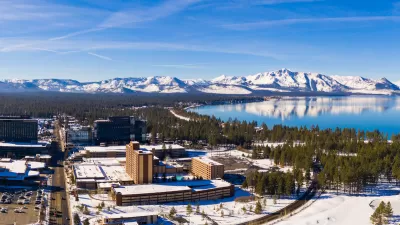The deplorable state of America's infrastructure may represent a one-time opportunity: not to replace what once made sense but does no longer, but to embark on a bold program to create a more environmentally sustainable nation, writes Sara Robinson.
"We all know the litany: the levees of New Orleans, the I-35 bridge in Minneapolis, overtaxed air traffic systems, construction cranes coming down all over, thousands of other structures quivering on their last legs. It's a slow-motion disaster-in-the-making.
It's not an overstatement to say that we may never have a creative opportunity like this one again. Even as our cities are crumbling around us, we're also finding ourselves in deep trouble on the energy front. [T]he more forward-thinking among us also realize now that solving this problem is going to require us to dramatically re-order our economy, invest in and invent new technologies, and completely re-think the way we build cities.
Those sprawling post-war cities made perfect sense in their time; but increasingly, they don't make sense in ours. But because all this stuff is already built-at a tremendous cost in money and material-it's also daunting to consider just how much of it will have to be rebuilt, refitted, or simply scrapped and replaced (or not) in order adapt to the new realities.
It's not enough to merely restore what's already there. We need to take an entirely fresh look at our assumptions about how cities and towns should be built, and put sustainability at the core of all our planning decisions."
FULL STORY: Acts of Creative Destruction: Rebuilding America for the 21st Century

Alabama: Trump Terminates Settlements for Black Communities Harmed By Raw Sewage
Trump deemed the landmark civil rights agreement “illegal DEI and environmental justice policy.”

Planetizen Federal Action Tracker
A weekly monitor of how Trump’s orders and actions are impacting planners and planning in America.

The 120 Year Old Tiny Home Villages That Sheltered San Francisco’s Earthquake Refugees
More than a century ago, San Francisco mobilized to house thousands of residents displaced by the 1906 earthquake. Could their strategy offer a model for the present?

In Both Crashes and Crime, Public Transportation is Far Safer than Driving
Contrary to popular assumptions, public transportation has far lower crash and crime rates than automobile travel. For safer communities, improve and encourage transit travel.

Report: Zoning Reforms Should Complement Nashville’s Ambitious Transit Plan
Without reform, restrictive zoning codes will limit the impact of the city’s planned transit expansion and could exclude some of the residents who depend on transit the most.

Judge Orders Release of Frozen IRA, IIJA Funding
The decision is a victory for environmental groups who charged that freezing funds for critical infrastructure and disaster response programs caused “real and irreparable harm” to communities.
Urban Design for Planners 1: Software Tools
This six-course series explores essential urban design concepts using open source software and equips planners with the tools they need to participate fully in the urban design process.
Planning for Universal Design
Learn the tools for implementing Universal Design in planning regulations.
Clanton & Associates, Inc.
Jessamine County Fiscal Court
Institute for Housing and Urban Development Studies (IHS)
City of Grandview
Harvard GSD Executive Education
Toledo-Lucas County Plan Commissions
Salt Lake City
NYU Wagner Graduate School of Public Service





























